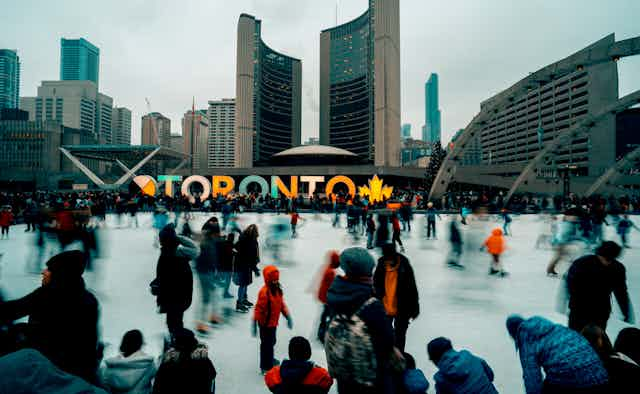In large Canadian cities, public ice rinks are a common feature. Over half of Canada’s 25 largest cities run free outdoor ice-skating rinks. The rinks are hockey-free and often have user-friendly design features (sloped access points, warming rooms, public washrooms) and are located close to central public transport hubs.
Crucially, they are free to use. Just bring your skates. The pandemic, unfortunately, has put limits on skating. Some rinks require advance registration and limit the number of people on the ice at one time, and skate rentals may not be available.
While there is no doubting hockey’s iconic status in Canada, we feel these local skating rinks are often overlooked in our cultural dialogues. So, last winter, we got together with our Sociable Cities research team to analyze two outdoor public ice rinks.
Based on 100 hours of “naturalistic and participant observation” (let’s call it watching and skating) we found that these rinks are a distinctive kind of public space, and not only because of the ice. They’re spaces for winter exercise and leisure, with all types of skill levels and configurations present: solo skaters, families and friends, beginning skaters, adapted skaters and skilled skaters.
These ice rinks are also places for sociability between strangers, where people mingle, chat and assist each other with ease. Significantly, these rinks are diverse in many ways: race, ethnicity, gender, age, ability, religion, immigration status. An ethos of reciprocal respect, mutual support and sociability seems to rule on and around the ice. People trust strangers to watch personal belongings, help tie skates and offer a steadying hand. Someone may even watch your kids as you get a coffee or grab a bite. Public-spiritedness, openness to differences and winter fun are part of the everyday life of these rinks.
These findings are in contrast to research on hockey’s long history of exclusivity, with some evidence that hockey is increasingly becoming the preserve of the wealthy. Hockey also has an ongoing serious diversity problem. Across recreational, amateur and professional levels, there are now regular reports of racism against Black and Indigenous players, toxic masculinity and homophobia. While these problems plague the men’s game, female players and fans report similar issues. There have been some moves to address these problems, with much room to grow.

Freedom to fail
In our recently published research we identify several features that support sociable interactions between strangers at local ice rinks. Two important characteristics promote this dynamic: the freedom to fail and the temporary suspension of social hierarchies.
Maybe your last time at the rink involved sliding into a stranger, tripping onto the ice or avoiding a fall by reaching for a passing stranger’s arm. It’s not just you.
Our observations show that such things happen all the time. The rink’s a place where you don’t need to be your best self: it’s OK to fall … and fail. Embarrassment aside, there’s a lot of judgment-free space for you to practise skating. And, when things go wrong, someone will likely offer to help. So long as no one’s seriously hurt, you’ll probably also share a laugh with a stranger. What could be perceived as a vulnerability is the thing that brings strangers together.
Our research documents everything from small signs of support — sympathetic winces, nods of recognition, encouraging words — to more sustained support for novice skaters. This includes strangers helping frustrated beginners to tie their laces, assisting nervous skaters onto the ice and providing impromptu skating lessons (“watch the ankles,” “bend your knees”). At the rink, being less than perfect is part of the fun.

Helping strangers
Another unique feature of the public rink is the temporary suspension of social hierarchies. Markers of social status appear a little less pronounced than in many other contexts, in part because these rinks are non-commercial spaces. Normal social boundaries blur, so there’s relaxed contact between strangers as they encourage, cajole, fall or assist each other.
Diverse identities mix on the ice. Age hierarchies are often reversed: adults fall over and children check that they’re OK as they help them up. Older folks seek advice and defer to the on-ice expertise of young people.
This sort of intergenerational play between strangers is really special, as few public spaces allow for play across generations, with play too often restricted by age and space in western culture. Playgrounds are built explicitly for children, so once children age out (usually by 12), their caregivers lose access to a space where they too might play and meet other caregivers.
Taken together, we call these positive characteristics “soft infrastructures of sociability.” Like all infrastructure, they require regular maintenance, and we all have a stake in maintaining them. Municipalities are wise to provide the material and social supports needed to maintain these kinds of spaces.
While we have ample evidence of sociable interactions, we aren’t claiming that these public rinks are perfect. Skaters’ experiences aren’t necessarily universally positive. Even with the rink’s considerable conviviality and diversity, we also found some evidence of interactions that patrol social differences, and how these rinks may operate as “white spaces,” or settings that were previously white-dominated and therefore not entirely comfortable for Black, Indigenous or other people of colour. The next phase of our research will interview skaters to dig deeper.
As Canadians settle in for a winter where the pandemic will no doubt continue to wear us down, our social lives will continue to move outside. Free and accessible outdoor leisure spaces where we can engage in easy sociability with one another — both people we know and strangers — are more important than ever. The outdoor public rink may help some of us feel a little less alone.

